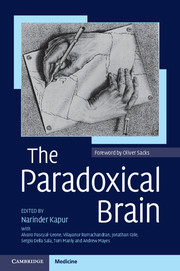Book contents
- Frontmatter
- Contents
- Acknowledgements
- Preface
- Foreword
- Author affiliations
- Abbreviations
- 1 The paradoxical nature of nature
- 2 Paradoxical effects of sensory loss
- 3 Paradoxical functional facilitation and recovery in neurological and psychiatric conditions
- 4 Paradoxes in neurorehabilitation
- 5 The paradoxical self
- 6 Paradoxical psychological functioning in early child development
- 7 Cognitive ageing: a positive perspective
- 8 Paradoxes of learning and memory
- 9 The paradox of human expertise: why experts get it wrong
- 10 Paradoxes in Parkinson's disease and other movement disorders
- 11 Paradoxical phenomena in epilepsy
- 12 Paradoxical creativity and adjustment in neurological conditions
- 13 Paradoxical functional facilitation with noninvasive brain stimulation
- 14 Unexpected benefits of allergies and cigarette smoking: two examples of paradox in neuroepidemiology
- 15 The paradox of autism: why does disability sometimes give rise to talent?
- 16 Paradoxes in creativity and psychiatric conditions
- 17 The paradox of psychosurgery to treat mental disorders
- 18 The paradox of electroconvulsive therapy
- 19 Paradoxes of comparative cognition
- 20 Paradoxical phenomena in brain plasticity
- 21 Immature neurons in the adult brain. Breaking all the rules
- 22 The paradoxical hippocampus: when forgetting helps learning
- 23 Paradoxical effects of drugs on cognitive function: the neuropsychopharmacology of the dopamine and other neurotransmitter systems
- 24 The paradoxical brain – so what?
- Index
- References
12 - Paradoxical creativity and adjustment in neurological conditions
Published online by Cambridge University Press: 05 December 2011
- Frontmatter
- Contents
- Acknowledgements
- Preface
- Foreword
- Author affiliations
- Abbreviations
- 1 The paradoxical nature of nature
- 2 Paradoxical effects of sensory loss
- 3 Paradoxical functional facilitation and recovery in neurological and psychiatric conditions
- 4 Paradoxes in neurorehabilitation
- 5 The paradoxical self
- 6 Paradoxical psychological functioning in early child development
- 7 Cognitive ageing: a positive perspective
- 8 Paradoxes of learning and memory
- 9 The paradox of human expertise: why experts get it wrong
- 10 Paradoxes in Parkinson's disease and other movement disorders
- 11 Paradoxical phenomena in epilepsy
- 12 Paradoxical creativity and adjustment in neurological conditions
- 13 Paradoxical functional facilitation with noninvasive brain stimulation
- 14 Unexpected benefits of allergies and cigarette smoking: two examples of paradox in neuroepidemiology
- 15 The paradox of autism: why does disability sometimes give rise to talent?
- 16 Paradoxes in creativity and psychiatric conditions
- 17 The paradox of psychosurgery to treat mental disorders
- 18 The paradox of electroconvulsive therapy
- 19 Paradoxes of comparative cognition
- 20 Paradoxical phenomena in brain plasticity
- 21 Immature neurons in the adult brain. Breaking all the rules
- 22 The paradoxical hippocampus: when forgetting helps learning
- 23 Paradoxical effects of drugs on cognitive function: the neuropsychopharmacology of the dopamine and other neurotransmitter systems
- 24 The paradoxical brain – so what?
- Index
- References
Summary
Summary
In recent years, the paradoxical occurrence of creativity and related behaviours in patients with neurological conditions has begun to gain attention. Relevant examples include the emergence of previously unrecognized visual and musical creativity in the context of the neurodegenerative illnesses such as Alzheimer's disease and frontotemporal dementia, and also in some cases of stroke. The description of these phenomena has helped to influence models of the neural underpinnings of creativity. Specifically, it is possible that down-regulation of frontal or anterior temporal function may enable spontaneous creative insights that originate in other regions of the brain. However, other explanations may also be tenable, and further research needs to be carried out to gauge why certain individuals and not others with neurological conditions become creative, and how this enhanced creativity may be understood in terms of specific cognitive processes and neural systems.
Introduction
Neurological conditions are inevitably accompanied by deficits, disabilities and handicaps – problems that are emphasized by the patients' loved ones, clinicians and researchers alike. In rare instances, however, neurological changes have led to observations of enhanced function, including the domain of creativity. For example, Lythgoe and colleagues described a patient who, following a subarachnoid haemorrhage, showed an all-encompassing compulsion to sculpt, draw and paint, having shown no premorbid interest in art (Lythgoe et al.,2005). Defining and measuring creativity has proven to be a monumental task, and taken together with the considerable individual differences in response to brain damage, evidence unambiguously demonstrating increased creativity is scarce.
- Type
- Chapter
- Information
- The Paradoxical Brain , pp. 221 - 233Publisher: Cambridge University PressPrint publication year: 2011



